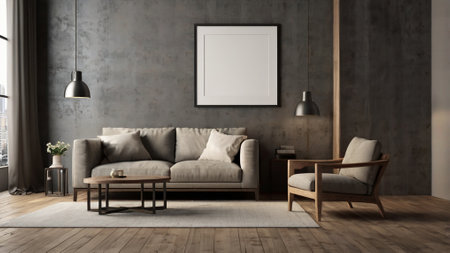1. Making a Statement with Ceilings
When it comes to living room design, most people focus on furniture, wall colors, or flooring. But have you ever looked up? Your ceiling offers a huge opportunity to add personality and style to your space. Statement ceilings are gaining popularity in American homes as a way to elevate the entire room without taking up any floor space.
Why Choose a Statement Ceiling?
The ceiling is often called the “fifth wall” for a reason—it can completely transform how your living room feels. Whether you want to add depth, texture, or just something unexpected, updating your ceiling can make all the difference. Plus, it’s a great conversation starter when guests walk in.
Popular Statement Ceiling Styles
There are several ways to create a statement ceiling that suits your taste and complements the rest of your decor. Here are some popular options:
| Ceiling Style | Description | Best For |
|---|---|---|
| Coffered Ceilings | Features a grid of recessed panels; adds depth and sophistication. | Traditional or upscale interiors |
| Beamed Ceilings | Exposed wooden beams create warmth and rustic charm. | Farmhouse, rustic, or industrial styles |
| Painted Ceilings | Adds color or pattern for a bold visual impact. | Modern or eclectic spaces |
| Wallpapered Ceilings | Uses wallpaper for texture or pattern overhead. | Creative and artistic rooms |
| Tin or Metallic Tiles | Adds vintage flair with reflective surfaces. | Historic homes or glam-inspired designs |
Tips for Choosing the Right Ceiling Design
- Match your home’s architecture: If you live in a Craftsman-style home, coffered or beamed ceilings work beautifully.
- Consider room height: Low ceilings benefit from lighter colors and simpler designs, while high ceilings can handle more dramatic treatments.
- Create contrast: A darker ceiling color can make your living room feel cozy, while lighter shades open up the space.
- Add lighting elements: Incorporating recessed lighting or chandeliers enhances both form and function.
Pro Tip:
If youre not ready to commit to a full ceiling makeover, try painting just the edges or using removable wallpaper panels for a temporary change. It’s an easy way to test out bold ideas without long-term commitment.
A well-designed ceiling doesn’t just top off your living room—it elevates the entire atmosphere. From intricate woodwork to striking paint choices, making a statement above eye level is one of the smartest ways to refresh your living space.
2. Bold Walls that Reflect Personality
Adding bold walls to your living room is one of the easiest and most impactful ways to express your personality through home decor. Whether you’re into vibrant colors, unique patterns, or artistic murals, your walls can become a canvas that tells your story and energizes the entire space.
Choose Colors That Speak to You
Color has a powerful effect on mood and atmosphere. Bold doesn’t always mean bright—deep navy blues, rich forest greens, or even moody charcoals can make a strong statement. The key is to pick hues that resonate with you and complement your furniture and lighting.
| Color | Mood/Effect | Best Paired With |
|---|---|---|
| Navy Blue | Calming, sophisticated | Gold accents, white trim |
| Emerald Green | Lush, energizing | Wood tones, brass fixtures |
| Terracotta | Warm, earthy | Creams, natural fibers |
| Burgundy | Dramatic, cozy | Velvet textures, dark wood |
Add Drama with Wallpaper
If painting feels too permanent or limited, wallpaper offers endless options for adding visual interest. From geometric prints to floral designs, there’s a pattern out there that matches your vibe. Peel-and-stick wallpapers are also renter-friendly and easy to update when your style evolves.
Popular Wallpaper Styles:
- Tropical leaves for a relaxed vacation feel
- Art deco patterns for vintage glamour
- Mediterranean tiles for a touch of culture
- Abstract shapes for modern minimalism
Create an Accent Wall with Mural Art
Mural art adds a one-of-a-kind flair that turns your wall into a true centerpiece. You can hire a local artist for a custom piece or use mural wallpaper for a more budget-friendly option. Themes like nature scenes, cityscapes, or even personalized illustrations make your living room truly yours.
Mural Placement Tips:
- A behind-the-sofa mural creates depth and focus.
- An entry wall mural sets the tone as soon as you walk in.
- A full-wall mural works best in rooms with minimal furniture.
Your walls aren’t just background—they’re part of the story you’re telling through design. Go bold and let your personality shine through every inch of paint, print, or brushstroke.

3. Layering Textures for Warmth and Depth
Creating a cozy and visually interesting living room goes beyond color and furniture placement. One of the easiest ways to add warmth and depth is by layering different textures throughout your space. When you mix materials like soft throws, woven rugs, plush cushions, and wooden or metal accents, your living room instantly feels more inviting and complete.
Why Texture Matters in Living Room Decor
Texture adds dimension that flat surfaces simply cant achieve. Even in rooms with neutral or minimal color palettes, varied textures keep the space from feeling sterile or boring. It’s about engaging not just sight, but touch — making your home feel lived-in and loved.
Simple Ways to Layer Textures
You don’t need a full makeover to start layering textures. Here are some practical tips:
- Rugs: Use area rugs to ground your seating area. Try natural fibers like jute for an earthy vibe, or go with shag or wool for a softer touch underfoot.
- Throws & Pillows: Add chunky knit throws and velvet or faux fur pillows to your sofa or armchairs. Mixing fabrics creates visual interest without overwhelming the space.
- Curtains: Swap out plain curtains for textured linens or layered drapes. They soften the room while adding depth to your walls.
- Furniture Materials: Combine leather, wood, metal, and upholstery in your furniture choices. A leather chair next to a wooden coffee table and fabric sofa can create beautiful contrast.
Texture Layering Ideas at a Glance
| Element | Suggested Material | Effect |
|---|---|---|
| Rug | Wool, Jute, Shag | Adds softness and defines space |
| Sofa Throw | Knit, Faux Fur | Adds coziness and casual charm |
| Pillows | Cotton, Velvet, Linen | Adds color and tactile interest |
| Curtains | Linen, Sheer Layers | Adds flow and height to walls |
| Accent Furniture | Wood, Metal, Rattan | Adds contrast and character |
Mix Without Mess: Keep It Balanced
The key to effective texture layering is balance. Stick with a consistent color palette so that even if you’re mixing materials — like pairing a leather ottoman with a linen couch — everything still feels cohesive. Choose two to three main textures as your base, then sprinkle in smaller accents for variety.
4. Mixing Modern and Vintage Accents
Blending modern and vintage accents in your living room is a great way to create a space that feels both stylish and full of character. By combining sleek, contemporary furniture with antique or heirloom pieces, you can achieve a look thats uniquely personal and visually interesting. Its all about balance—mixing clean lines with nostalgic touches for a curated vibe that feels fresh yet timeless.
Why This Combo Works
Modern design tends to favor minimalism, neutral colors, and smooth finishes. On the other hand, vintage or antique items bring in texture, history, and often a bit of quirkiness. When paired thoughtfully, these elements complement each other instead of clashing. For example, a mid-century modern sofa can look stunning next to an ornate vintage coffee table or an old-school credenza.
Tips for Mixing Styles Successfully
- Create a Focal Point: Let one standout piece—like a retro armchair or bold modern art—anchor the room.
- Stick to a Color Palette: Use color to tie everything together. Neutrals work well as a base, allowing different styles to coexist peacefully.
- Balance Proportions: Mix large and small pieces evenly throughout the room so nothing feels out of place.
- Edit Thoughtfully: Avoid overcrowding. Too many statement pieces can compete rather than complement.
Examples of Modern & Vintage Pairings
| Modern Piece | Vintage Accent | Why It Works |
|---|---|---|
| Sleek sectional sofa | Distressed leather trunk (as coffee table) | Adds warmth and texture against clean lines |
| Acrylic bookshelf | Aged brass floor lamp | Marries contemporary transparency with old-world charm |
| Minimalist TV stand | Antique mirror above it | Adds reflection and visual height while nodding to the past |
The Key: Intentional Design Choices
The goal isn’t to make your living room feel like a museum or a showroom—it’s about telling your story through design. Whether it’s a grandmother’s rocking chair or a flea market find, mixing these vintage treasures with new favorites creates depth and personality in your home. And when paired with bold walls or statement ceilings, the contrast becomes even more striking and memorable.
5. Smart Lighting for Style and Function
Lighting plays a huge role in setting the mood and functionality of your living room. When youre working with bold walls or statement ceilings, choosing the right lighting can highlight these features and make your space feel more inviting and well-designed. Instead of relying on just one overhead light, think about using layered lighting to create depth and flexibility.
Layered Lighting Basics
Layered lighting means using different types of light sources in one space. This helps balance brightness, reduce shadows, and add visual interest. Here’s how to break it down:
| Lighting Type | Purpose | Examples |
|---|---|---|
| Ambient Lighting | Main source of light for overall illumination | Ceiling fixtures, recessed lights |
| Task Lighting | Focused lighting for activities like reading or working | Floor lamps, table lamps, adjustable sconces |
| Accent Lighting | Used to highlight architectural features or decor | Wall sconces, LED strip lights, picture lights |
Choosing Fixtures That Match Your Style
If you have a statement ceiling—like coffered designs or bold paint colors—a chandelier or pendant light can draw attention upward and tie the look together. Go for styles that complement your ceiling detail: modern chandeliers for sleek lines or vintage-inspired fixtures for traditional touches.
Bolder wall colors or patterns pair well with minimalist lighting so the space doesn’t feel too busy. For example, simple matte black sconces can contrast beautifully with jewel-toned walls while adding cozy pockets of light.
Pro Tip:
Dimmers are a must! They let you adjust brightness depending on the time of day or mood you’re going for.
Create Zones With Light
If your living room serves multiple purposes—like entertaining guests, relaxing with family, or working from home—use lighting to define those zones. A floor lamp next to a reading chair makes that area feel purposeful. Meanwhile, a dramatic chandelier over the coffee table anchors the seating area and adds style.
Quick Ideas to Try:
- Add plug-in wall sconces if hardwiring isn’t an option—they’re renter-friendly and stylish.
- Use smart bulbs to control color temperature and brightness through your phone.
- Mix materials like brass, glass, or rattan in your lighting fixtures to add texture and personality.
The right mix of lighting not only makes your living room more functional but also enhances all the bold design choices you’ve made—from eye-catching ceilings to vibrant walls. Let your light fixtures do double duty: practical during the day and stunning at night.


